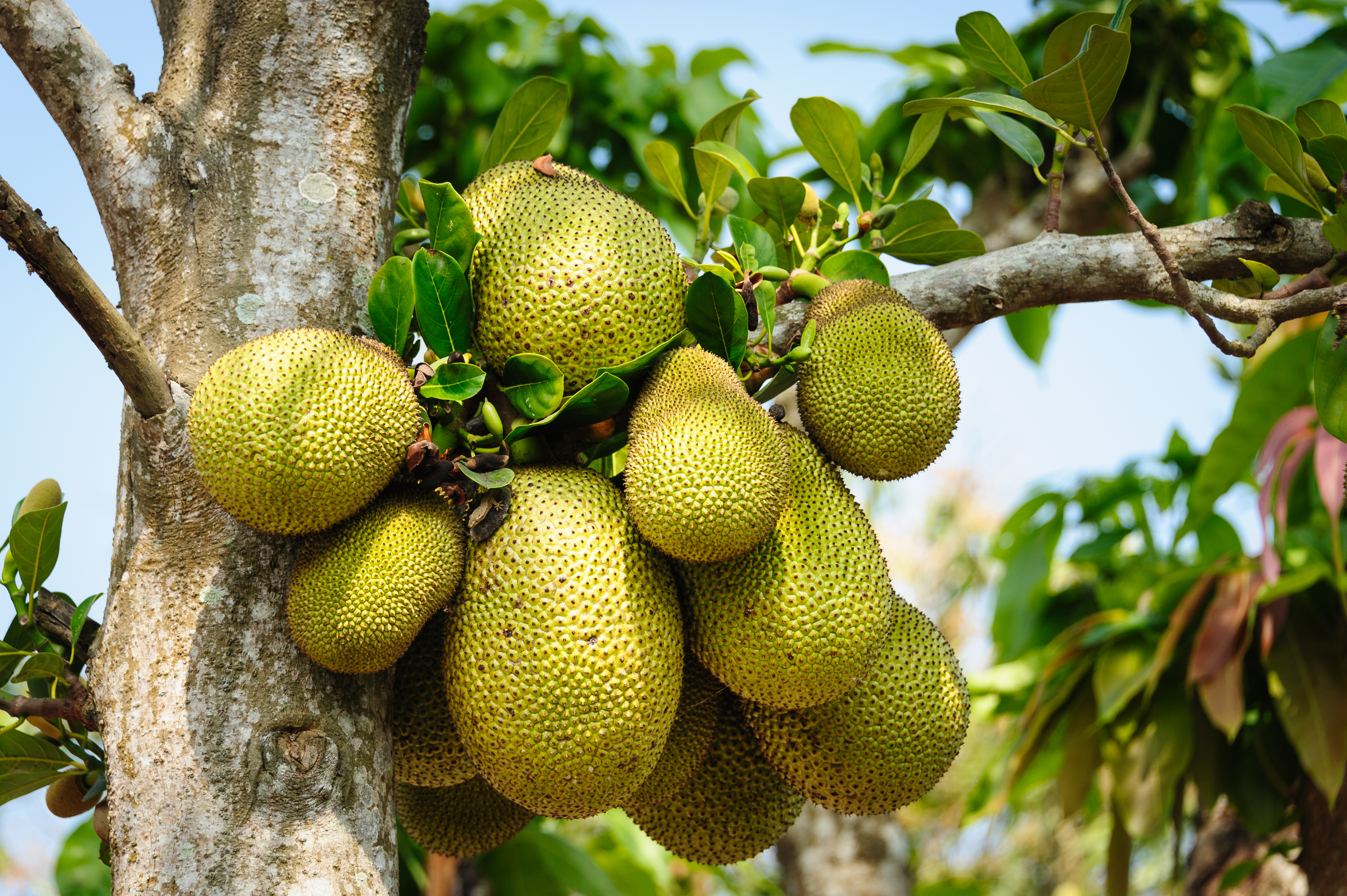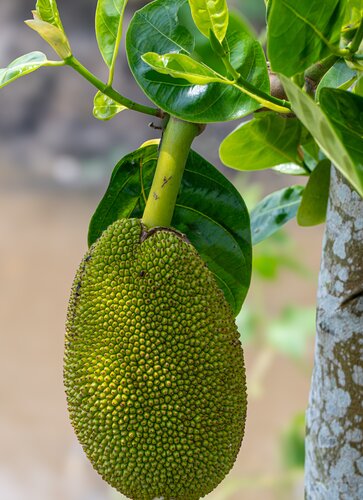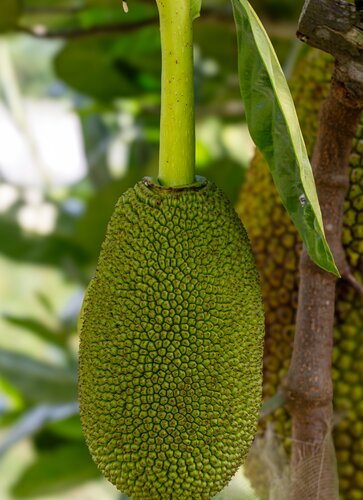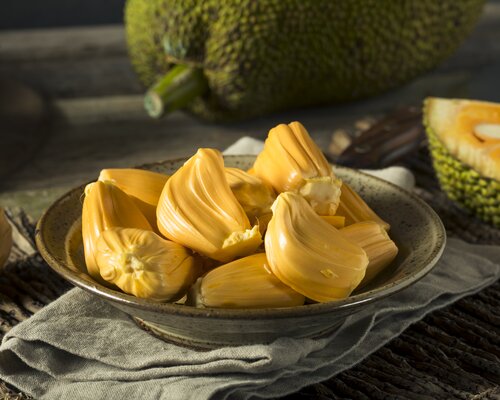Jackfruit
Artocarpus heterophyllus
Crop Overview
Jackfruit (Artocarpus heterophyllus Lam.) is a large, evergreen fruit tree belonging to the fig, mulberry and breadfruit family. Common names include jackfruit, jak, nangka and kathal. It produces huge fruits weighing up to 55 kg, measuring 90 cm in length and 50 cm in diameter. The unripe fruit is cooked as a vegetable and the pulp of the ripe fruit is eaten fresh. The seeds are roasted, boiled, or steamed. It is a staple food in parts of South and Southeast Asia.
Jackfruit originated in the rainforests of the Western Ghats in India and now grows in Southeast Asia, tropical Africa and the Caribbean.
Characteristics, Cultivation and Agricultural Practices
Jackfruit thrives in warm, humid tropical climates, favoring well-drained, sandy loam soils and requiring high annual rainfall of 1,000–2,400 mm. Although it grows best in regions with consistent rainfall, it shows some drought tolerance once established due to its deep root system. The tree is generally resistant to pests and diseases, though it may face challenges from fruit borers, scale insects and fungal issues under some conditions.
Under ideal growing conditions, jackfruit trees can yield 100–200 fruits per tree annually. Its yield potential varies depending on the variety, cultivation practices and climate. Jackfruit is often cultivated in smallholder agroforestry systems, frequently intercropped with coconut, coffee or banana. Its ability to grow on marginal land makes it a popular choice for small-scale farmers and backyard growers alike.
Nutritional, Economic and Medicinal Value
Jackfruit is highly nutritious, containing carbohydrates, fiber, protein and essential vitamins and minerals. It is rich in vitamins A and C and magnesium. The fruit also contains high levels of several chemicals that help lower blood sugar. The unripe fruit is popular as a meat substitute in vegetarian and vegan diets. Additionally, its seeds are high in protein.
Jackfruit holds a prominent place in local diets in many tropical regions, where it is used in curries, desserts and snacks. It is also used to make syrups, jams, flour, noodles and dried chips eaten as a snack.
Latex from jackfruit is commonly used as adhesive for mending broken chinaware or earthenware, caulking boats, mending holes in buckets and trapping birds.
The timber of the jackfruit tree is durable and resistant to termites. It is often used in the construction of furniture, houses and musical instruments, particularly in Southeast Asia.
Jackfruit is used in traditional medicine to treat digestive issues, including ulcers, and manage blood sugar levels, and it provides anti-inflammatory benefits. The root and root extracts are used to treat skin disorders, asthma and diarrhea. It is used in Ayurvedic and Unani medicine to treat various ailments, including leprosy, ulcers, constipation, heart disease and rheumatism.
Cultural Importance
Jackfruit is the national fruit of Bangladesh and the state fruit of the southern Indian States of Tamil Nadu and Kerala. In parts of India, the fruit is associated with religious offerings, festivals and rituals, symbolizing abundance and prosperity. The wood is also used in construction of Buddhist temples in Vietnam and extracts from the heartwood are used to dye the robes of the monks of the forest Buddhist monasteries of Southeast Asia.
Gender Perspectives
Women play a significant role in jackfruit harvesting, processing and culinary preparation, particularly in small-scale production. It is commonly grown by women in backyard systems, although men dominate in commercial production systems. Jackfruit requires minimal agricultural inputs, making it an accessible crop for women who may not have access to extensive farming resources.
The increasing popularity of jackfruit as a plant-based meat substitute presents economic opportunities for women in both urban and rural settings. Empowering women through access to processing facilities, training, and market linkages could increase their engagement in jackfruit’s value-added production, enhancing their income and influence.
Why is the Crop Underutilized?
Despite its benefits, jackfruit remains underutilized due to several challenges. The large size of the fruit and its unique odor can make it difficult to handle and transport, while a lack of storage and preservation options limits its marketability. Additionally, processing jackfruit can be labor-intensive, which discourages commercial production in some regions. Limited awareness of its nutritional benefits and relatively low consumer demand compared with other fruits also contribute to its underutilization.
However, jackfruit’s rising popularity as a meat substitute has opened new markets and opportunities for increased cultivation. Awareness campaigns, improved processing techniques and better distribution infrastructure could help elevate jackfruit’s profile, leading to increased production and market expansion. Research to simplify processing, extend shelf life and develop value-added products could further support its adoption.
Diversity Available in Genesys
As of December 2024, Genesys, the online information platform about plant genetic resources for food and agriculture conserved in genebanks worldwide, lists only 17 samples of jackfruit. Of these:
- 10 of them are held at the Subtropical Horticultural Research Unit, National Germplasm Repository, Miami, Florida, USA.
- Six samples are shown as advanced or improved varieties.
Current Breeding Efforts
To date, few significant jackfruit breeding programs have been identified and research is ongoing.





